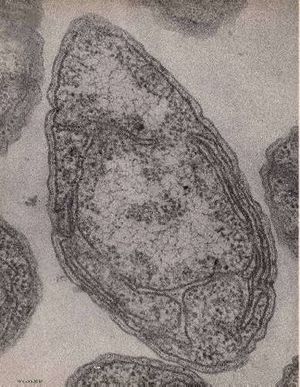Nitrosomonas eutropha: Difference between revisions
| Line 41: | Line 41: | ||
Does it have any plasmids? Are they important to the organism's lifestyle? | Does it have any plasmids? Are they important to the organism's lifestyle? | ||
The genome of ''Nitrosomonas eutropha'' consists of one chromosomes and two plasmids. The length of the chromosome is observed to be 2.7 megabase pairs (Mbp) and encodes 2443 proteins and 47 RNAs. The two plasmids have a length of 0.065 Mbp and 0.056 Mbp respectively and encode for 55 and 52 proteins respectively. | The genome ''Nitrosomonas eutropha'' has not been discovered for all strains, but the genome of ''Nitrosomonas eutropha C91 C71'' has been sequences and researched extensively. The genome of ''Nitrosomonas eutropha C91 C71'' consists of one chromosomes and two plasmids. The length of the chromosome is observed to be 2.7 megabase pairs (Mbp) and encodes 2443 proteins and 47 RNAs. The two plasmids have a length of 0.065 Mbp and 0.056 Mbp respectively and encode for 55 and 52 proteins respectively. | ||
==Cell structure and metabolism== | ==Cell structure and metabolism== | ||
Revision as of 09:50, 3 May 2007
A Microbial Biorealm page on the genus Nitrosomonas eutropha
Classification
Higher order taxa
Domain; Phylum; Class; Order; family [Others may be used. Use NCBI link to find]
Domain: Bacteria
Phylum: Proteobacteria
Class: Betaproteobacteria
Order: Nitrosomonadales
Family: Nitrosomonadaceae
Genus: Nitrosomonas
Species: N. eutropha
Species
|
NCBI: [1] |
Nitrosomonas eutropha
Description and significance
Describe the appearance, habitat, etc. of the organism, and why it is important enough to have its genome sequenced. Describe how and where it was isolated. Include a picture or two (with sources) if you can find them.
Nitrosomonas eutropha can be found in strongly eutrophic environments (those rich in organic nutrients and minerals) such as sewage disposal systems. Nitrosomonas eutropha also has a high tolerance for elevated ammonia concentrations. Nitrosomonas eutropha is able to grow anaerobically, utilizing nitrite as an electron acceptor and H2 as a reductant.
Genome structure
Describe the size and content of the genome. How many chromosomes? Circular or linear? Other interesting features? What is known about its sequence? Does it have any plasmids? Are they important to the organism's lifestyle?
The genome Nitrosomonas eutropha has not been discovered for all strains, but the genome of Nitrosomonas eutropha C91 C71 has been sequences and researched extensively. The genome of Nitrosomonas eutropha C91 C71 consists of one chromosomes and two plasmids. The length of the chromosome is observed to be 2.7 megabase pairs (Mbp) and encodes 2443 proteins and 47 RNAs. The two plasmids have a length of 0.065 Mbp and 0.056 Mbp respectively and encode for 55 and 52 proteins respectively.
Cell structure and metabolism
Describe any interesting features and/or cell structures; how it gains energy; what important molecules it produces.
Nitrosomonas eutropha usually has a pleomorphic shape, appearing to resemble the shape of a rod to a pear, with the ability to be motile and is occasionally also found in short chains. Nitrosomonas eutropha is a gram-negative betaproteobacterium and related to the better studied Nitrosomonas europaea.
Nitrosomonas eutropha primarily uses CO2 as it's carbon source. As an ammonia-oxidizing bacteria, Nitrosomonas eutropha catalyzes the oxidation of ammonia in order to meet its energy requirements for growth. The process of the oxidation of ammonia to nitrite is an importatnt part of the biogeochemical Nitrogen Cycle, resulting in the step providing to plants the nitrogen they require to carry out the cycle. As a result, Nitrosomonas eutropha is also involved with limiting CO2 fixation. Also as an ammonia-oxidizing bacteria, Nitrosomonas eutropha is believed to contribute significantly to the global production of nitrous oxide, a product of nitrite reduction.
Ecology
Describe any interactions with other organisms (included eukaryotes), contributions to the environment, effect on environment, etc.
Pathology
How does this organism cause disease? Human, animal, plant hosts? Virulence factors, as well as patient symptoms.
Application to Biotechnology
Does this organism produce any useful compounds or enzymes? What are they and how are they used?
Current Research
Enter summaries of the most recent research here--at least three required
References
Chain, P., J. Lamerdin, F. Larimer, W. Regala, V. Lao, M. Land, L. Hauser, A. Hooper, M. Klotz, J. Norton, L. Sayavedra-Soto, D. Arciero, N. Hommes, M. Whittaker, D. Arp. 2003. "Complete genome sequence of the ammonia oxidizing bacterium and obligate chemolithoautotroph Nitrosomonas europaea". J. Bacteriol. 185: 2759-2773.
Koops H-P, Böttcher B, Möller U, Pommerening-Röser A, Stehr G. "Classification of eight new species of ammonia-oxidizing bacteria: Nitrosomonas communis sp. nov., Nitrosomonas ureae sp. nov., Nitrosomonas aestuarii sp. nov., Nitrosomonas marina sp. nov., Nitrosomonas nitrosa sp. nov., Nitrosomonas eutropha sp. nov., Nitrosomonas oligotropha sp." nov. J Gen Microbiol. 1991; 13 :1689-1699.
Edited by student David Herrera of Rachel Larsen and Kit Pogliano

